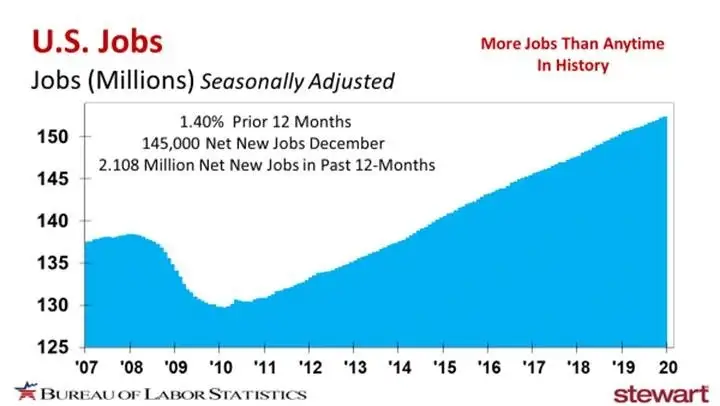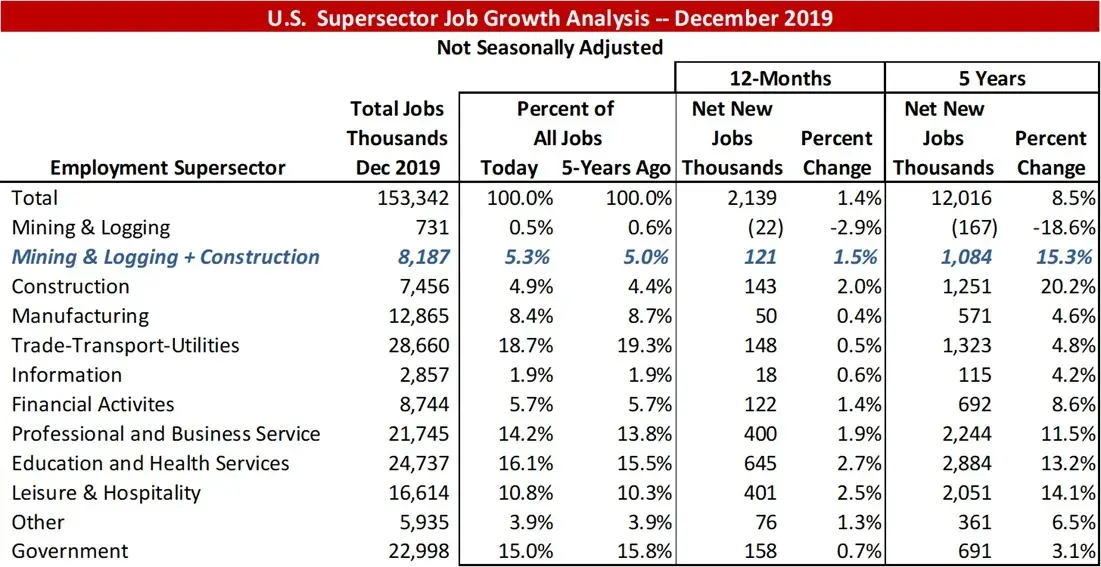U.S. Jobs Report December 2019 -- Who Knew Average Would Look So Good?
The statement, “Jobs are everything to an economy – Period,” is my top axiom regarding the economy. Jobs drive the ultimate demand for all types of real estate since they are essential to effective purchasing power.
An estimated 145,000 net new jobs were created in December 2019 (preliminary) as reported by the U.S. Bureau of Labor Statistics, with a total 2.108 million net new jobs in the past 12-months. The resulting 1.40 percent job growth rate compares to a 1.31 percent average compound annual growth rate in the past 40 years. Though the current job growth rate is just 9 basis points greater than the 40-year average at 1.40 percent, it is 6.4 percent greater. The following graph shows the total number of jobs monthly since 2007 on a seasonally adjusted basis.

Employment in the Leisure & Hospitality sector continues to be an excellent proxy (in my opinion) of the overall health index of the U.S. economy. People do not spend money on vacations, cruises, entertainment, spas or expensive dinners out unless they feel good about the future economy. My premise is that the U.S. economic outlook is healthy as long as the employment growth rate in Leisure & Hospitality matches or exceeds that of the country overall. Current Leisure & Hospitality job growth in the prior 12 months was 2.3 percent versus 1.4 percent for the total economy. At this time there is no recession on the horizon for 2020 foregoing unanticipated economic shocks, given the strong growth in Leisure & Hospitality employment. This essentially says that consumers continue to have a positive economic outlook.

Not only are more people working than ever before in history in the U.S., those working saw the largest increase in average hourly wages in a decade in 2019. Average hourly wage rose from $27.53 a year ago to $28.32 in December, a gain of 2.9 percent. In comparison, inflation (as indicated by the change in CPI – All Urban Consumers) was 2.0 percent.

The unemployment level varies by education attainment as shown in the table. Education and age (a proxy for experience) are both positively correlated to reduced levels of unemployment.

Other select items in the December 2019 jobs report:
- Number of Persons Unemployed for Less Than 5 Weeks increased by 39,000 from a month ago, and is now at 2.065 million versus 2.117 million a year ago (down 52,000)
- Long-Term Unemployed (jobless for 27 or more weeks) dropped by 33,000 compared to November and is now at 1.186 million versus 1.311 million a year ago
- Civilian Labor Force Participation Rate is 63.2 percent, up slightly from 63.0 percent a year ago – positive economic news
- Employment-Population Ratio is now 61.0 percent versus 60.6 percent a year ago – the bigger the better
- Number of Persons Employed Part Time for Economic Reasons (also known as involuntary part-time workers) are individuals desiring full-time employment but either had their hours cut back or cannot find a full-time job, declined by 507,000 from one year ago and is down to 4.148 million compared to 4.655 million in 2018
- Marginally Attached to the Labor Force (not currently counted in the labor force, want and are available for work and had looked for a job in the prior 12 months) now at 1.246 million was at 1.556 million a year ago. Within that group, 277,000 were classified as Discouraged Workers – persons not currently looking for work because they believe there are no jobs available for them, down from 375,000 a year ago, a drop of 98,000 or 26.1 percent
The next table shows the job change (in thousands) for Employment SuperSectors. The table shows the percent of all jobs per SuperSector as of December 2019 and five years ago. Education & Health Services, for example, added 645,000 net new jobs in the past 12-months and 2.884 million in the past five years) and made up 16.1 percent of all jobs as of December 2019. The largest percentage change in the prior five years was in Construction employment, which increased by 20.2 percent. SuperSector data are not-seasonally adjusted while all other data discussed are seasonally adjusted.

To read the latest press release from the BLS click https://www.bls.gov/news.release/pdf/empsit.pdf Average may not have ever sounded better – at least when it comes to the monthly U.S. jobs report.
Ted
